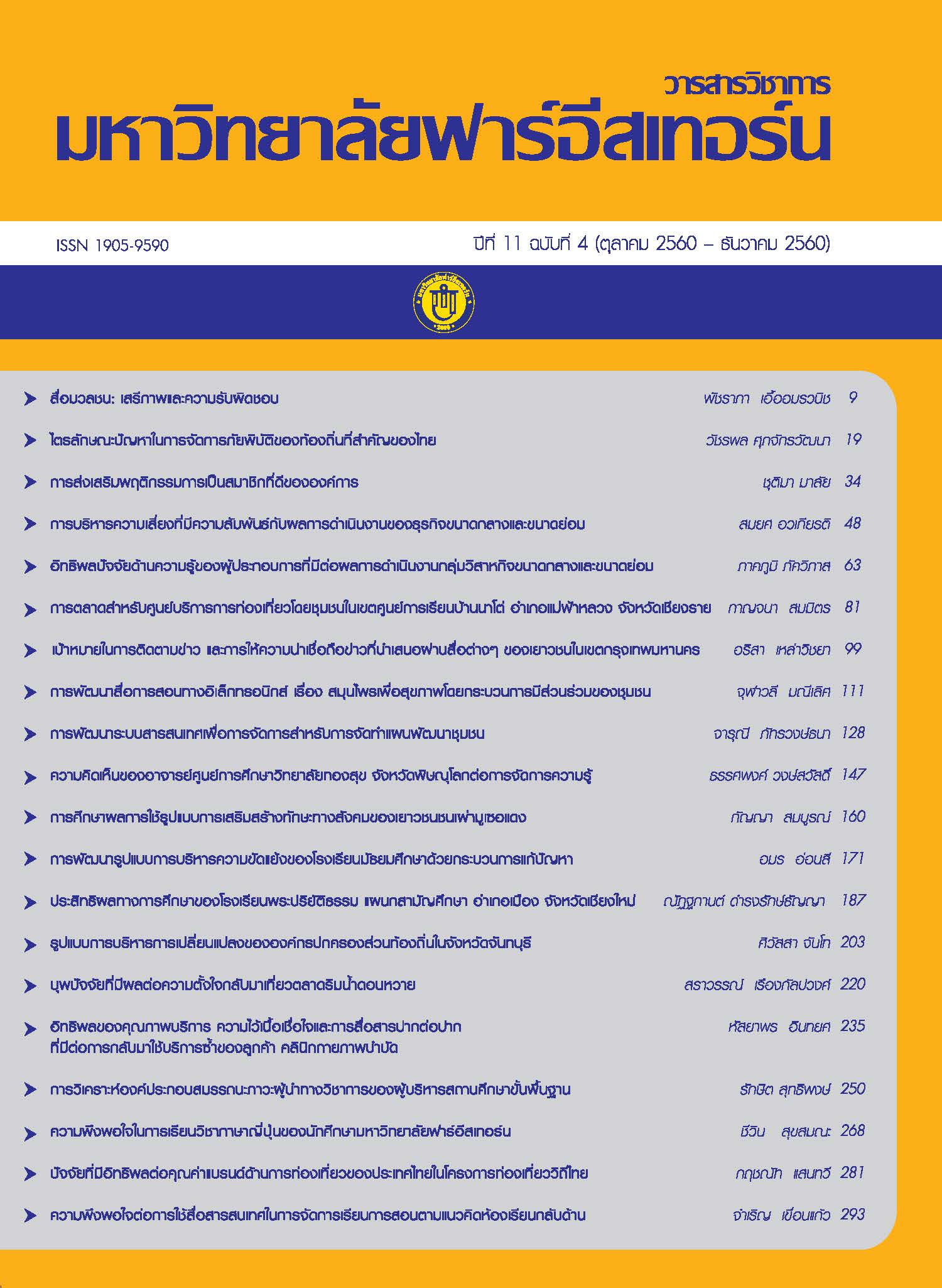ความพึงพอใจต่อการใช้สื่อสารสนเทศในการจัดการเรียนการสอน ตามแนวคิดห้องเรียนกลับด้าน
Main Article Content
บทคัดย่อ
การศึกษานี้มีวัตถุประสงค์เพื่อศึกษาความพึงพอใจในการเรียนที่มีการใช้สื่อสารสนเทศในการเรียนด้วยการจัดการเรียนการสอนตามแนวคิดห้องเรียนกลับด้านในรายวิชา IND410 ระบบบรรจุภัณฑ์สำหรับ
โลจิสติกส์ มีนักศึกษาที่ลงทะเบียนเรียนจำนวน 13 คนจัดรูปแบบการเรียนที่มอบหมายงานให้ผู้เรียนศึกษาเนื้อหาในรายวิชานอกชั้นเรียน โดยจัดการเรียนในรายวิชานี้ทั้งสิ้น 8 บทเรียนผ่านการใช้ชั้นเรียนออนไลน์และใช้เวลาในชั้นเรียนในการทำกิจกรรมและสนทนาแลกเปลี่ยนเนื้อหาที่ได้ศึกษามาก่อนเข้าเรียน จากนั้นทำการประเมินความพึงพอใจด้วยแบบสอบถามและวิเคราะห์ผลด้วยค่าสถิติเชิงพรรณนา ผลการศึกษาพบว่า ผู้เรียนมีความพึงพอใจในระดับสูงต่อการเรียนในรายวิชานี้โดยการมอบหมายงานนอกห้องเรียนสามารถทำให้ผู้เรียนกำหนดลำดับการเรียนและตั้งใจเรียนมากขึ้น ซึ่งผู้เรียนเชื่อว่ากระบวนการเรียนด้วยแนวคิดห้องเรียนกลับด้านให้ผลที่ดีกว่าและกระตุ้นให้ผู้เรียนได้ฝึกกระบวนการคิดมากกว่าการเรียนแบบเดิม รวมทั้งต้องการให้รายวิชาอื่นๆนำกระบวนเรียนแบบใหม่ไปประยุกต์ใช้
The purpose of this study was to evaluate students' satisfaction in using information media in Flipped Classroom concept design. This concept was designed in IND410 course, Packaging System for Logisticswith 13 students that enrolled in this course. Learning activities were assigned for students to study content outside class hours in form of online classeswith 8 units, Google Classroom, and the class time is spent on activities and discuss the content they have studied by themselves earlier. The satisfaction questionnaires were used and analyzed with descriptive statistics. The study indicated that student feedback are high with this course. Assigning tasks outside the classroom enable them to create their own pace in study. The learner believes that the learning process with the Flipped Classroom concept is more effective and use more critical thinking than traditional learning. Finally, student prefer to have more course designed with this concept.
Article Details
1. ทัศนะและข้อคิดเห็นใดๆ ในวารสารนวัตกรรมสังคมและการเรียนรู้ตลอดชีวิตเป็นทัศนะของผู้เขียน กองบรรณาธิการไม่จำเป็นต้องเห็นพ้องด้วยกับทัศนะเหล่านั้นและไม่ถือว่าเป็นความรับผิดชอบของกองบรรณาธิการ
2. ความรับผิดชอบด้านเนื้อหาและการตรวจร่างบทความแต่ละบทเป็นของผู้เขียนแต่ละท่าน กรณีมีการฟ้องร้องเรื่องการละเมิดลิขสิทธิ์ถือเป็นความรับผิดชอบของผู้เขียนแต่เพียงฝ่ายเดียว
3. ลิขสิทธิ์บทความเป็นของผู้เขียนและมหาวิทยาลัยฟาร์อีสเทอร์นได้รับการสงวนสิทธิ์ตามกฎหมาย การตีพิมพ์ซ้ำต้องได้รับอนุญาตโดยตรงจากผู้เขียนและมหาวิทยาลัยฟาร์อีสเทอร์นเป็นลายลักษณ์อักษร
เอกสารอ้างอิง
Gilboy, B. M., Heinerichs, S. and Pazzaglia, G.. (2015). Enhancing Student Engagement Using the Filpped Classroom. Journal of Nutrition Education and Behavior, 47(1), 109-114.
Herreid, F. C. and Schiller, A. N.. (2013). Case studies and the flipped classroom. Journal of College Science Teaching, 42, 62-66.
Mok, N. H.. (2014). Teaching Tip: The Flipped Classroom. Journal of Information Systems Education, 25(1), 7-11.
Moran, K. and Milsom, A.. (2015). The Flipped Classroom in Counselor Education. Counselor & Supervision, 54(March), 32-43.
Pangleela Burapapichitpai. (2015). The Flipped Classroom and Learning Management in Thailand. Department of Educational Technology, Faculty of Education, Kasetsart University.
Partnership for 21st Century Skills. (2016). Framework for 21st Century Learning. [Press release]. Retrieved October 16, 2016, from http://www.p21.org/storage/documents/docs/ P21_framework_0816.pdf
Simpson, V. and Richards, E.. (2015). Flipping the Classroom to teach population health: Increasing the relevance. Nurse Education in Practice, 15(2015), 162-167.
Wells, S. C. and Wollack, A. J.. (2003). An Instructor’s Guide to Understanding Test Reliability. Wisconsin: University of Wisconsin.
ปางลีลา บูรพาพิชิตภัย. (2558). The Flipped Classroom กับการจัดการเรียนการสอนในประเทศไทย. กรุงเทพฯ: ภาควิชาเทคโนโลยีการศึกษา คณะศึกษาศาสตร์มหาวิทยาลัยเกษตรศาสตร์.

